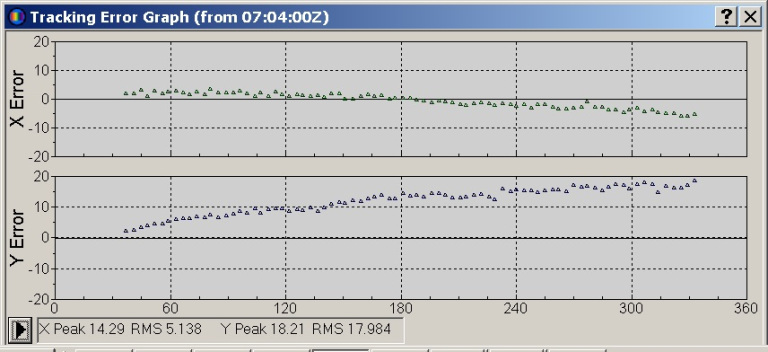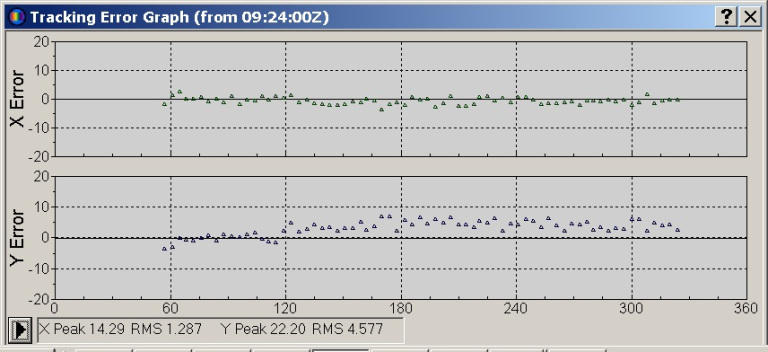After more than a year of trying, I am still having the same problem with my Paramount MX mount “drifting”.
The Goal: I would like to be able to do 10 minute unguided exposures using a wide field setup. My system has two telescopes and cameras:
Widefield: Sky90 refractor with SBig ST2000XM camera, 10 position filter wheel. Image scale is 3.7 arcseconds per pixel unbinned. The camera has a second guiding chip so sometimes I can guide. However, the various filters are pretty dim; even the regular RGB filters dim out guide stars. HAlpha, Oiii, and Sii need a very bright guide star. This is why I am looking to do unguided exposures. Various people have assured me that this mount should be capable in this configuration. As seen in the pictures, the Sky90 is mounted on the C11 with a wide Losmandy rail.
Narrow Field: Celestron 11″ mounted in a Homeyer cradle for stability. Uses an Optec focuser with a SBig STF8300M camera, 8 position filter wheel. Has the STi off axis guiding option. Image scale is 0.40 arcseconds per pixel. Guiding works fine with this setup, so unguided operation is not particularly needed. Might be nice, since I sometimes have to play around to get a guide star on the chip.
The Problem:
Without guiding, using the widefield setup, my stars drift (mostly in the RA direction). I end up with distinctly trailed stars in a 5 or 10 minute unguided exposure. This occurs with or without ProTrack running; I have a 350 point Tpoint model in place, with pretty good model results (I think:) as shown below. It appears that the drift is bigger than what ProTrack can handle.
To demonstrate/measure the problem, I run tests on the C11 (just to get more precise data at 0.4 as/px). I set up to autoguide using the STF8300 main camera (0.4 as/px). In Maxim I disable the guider relay outputs so the actual guiding corrections are not sent to the mount. PEC is enabled. I can then start “guiding” and watch the guide star’s movement over time.
The screen shot above is a typical example. In this 5 minute exposure I am looking at a star in the East. The RA guide error on the Y axis (my camera is turned 90 degrees to help balancing) steadily drifts about 20 pixels (8 arcseconds) over 300 seconds, for a net drift of 0.027 arcseconds per second. This same drift rate on the wide field setup results in a displacement of 4-5 pixels on the widefield system for a 10 minute exposure. I generally see 5-10 pixel star trails on the widefield system.
When looking at a star in the West, the RA drift may or may not be in the opposite direction. This example shows the drift in the same direction.
Note that there is also a slight drift in the Dec. In different tests, the Dec drift is either slight or negligible.
I know, the general buzzword is always Flexure. A convenient error, since we have no tools to measure flexure in the various hardware components. I have been blindly replacing components for awhile now.
Things I have done:
– Regreased the gears.
– Rerun PEC (after regreasing). The screenshot below shows the result of the new PEC measurement (Red line) versus the original PEC curve (green) from a year ago. THE PEC is essentially identical. PEC is obtained from 15 worm cycles using PemPro.
After installing the PEC curve, the PEC error is essentially zero as seen above. This also tells me I have not gotten the PEC curve installed inverted.
– Replaced the flimsy stock aluminum dovetail for the C11 with a Homeyer cradle. This makes the C11 incredibly solid on the Versa plate.
– Replaced the Sky90 rings with a Takahashi clam shell.
– Removed Telrad.
– Replaced Sky90 compression fitting holding the camera with a completely threaded optical train.
– Double checked balancing. The scope is as close to evenly balanced as I can make it, both in RA and Dec.
– Worked on polar alignment. I ran a number of 50 point TPoint models to obtain no error (Excellent Alignment, No Further Adjustment) in the Polar Alignment results screen. However, the 350 point model indicates I am still off by 2.1 arcminutes in Azimuth and 2.9 arcminutes in Altitude.
– Replaced previous external guide camera with STF8300 and STi Off axis guider. This doesn’t affect the Sky90 system directly, but perhaps could have contributed some sort of flexure.
– Ran some cables through the mount to reduce the number of wires in the pigtail. Rerouted the wires to correctly avoid “dragging” as the mount turns. The dragging had shown up in TPoint models. The current model does not show that pattern.
– Double/Triple checked tightness of various bolts.
– Tied down wiring on mount using Velcro straps. I assume wiring position changes would not lead to this type of drift.






Hi, I also own a Paramount MX, am in the southern hemisphere and experience this from time to time. Like you, I’ve run PEC, have a 150 point model, have maintained the mount, etc.
About the only thing I haven’t tried yet is to change my power extension chord to my observatory. I’m wondering if an adequate power or a ‘cleaner’ power supply might be the problem. I have a computer, the MX, a QHY8, powered hub and lately a Raspberry pi all running off the same power chord. I started to experience star trails and oblongs more lately than before and the only change I’ve made is a powered hub and the raspberry pi.
So next time I try to take some shots I’m going to turn off the Raspberry pi and see if that makes a difference. If the mount is experiencing intermittent power issues, it might be enough to cause odd errors without disconnecting it fro the computer.
I “assume” I do not have power issues, although I don’t know how to prove it. Most of my equipment is powered off a Digilogger 8 channel unit (ECP-II? or similar name) so I can turn things on/off remotely. I would certainly hope that unit provides clean power:) I suppose the local power grid itself could be doing something flakey, but it seems unlikely it would continue all night. I would expect something more along the lines of occasional low voltage, or occasional spikes.
I am running an Arduino for temperature measurements, and soon will add a second one for opening/closing the dome shutter. The Arduinos do not consume much power in general; I don’t know why they would affect the mount. The temperature Arduino receives power from a powered USB hub; the shutter unit will be powered from a very nice 35 Amp power supply.
I should say that my unit has been performing correctly for several months now. I do not know why, although I suspect it may have simething to do with a loose focuser. The Sky90 drawtube is sort of floppy. I had been experimenting on how to adjust it to remove the flop, but wasn’t really successful.
Hello,
I am also an owner of a PMX and I think you are right. I have seen similar drift since I have it. Lately I installed a Telescope Driver Master TDM (http://www.mda-telescoop.com/) which has confirmed this. The TDM high resolution rotary encoder allows to measure the actual RA shaft rotation rate very accurately (about 1/8″).
The actual sidereal rate is 15.041″ per second, this is the value uses by the TDM too.
In summary the analysis shows that the PMX sidereal rate is faster than the actual sidereal rate (15.041″) by 0.032″ per second, which about 2″ per minute, which is quite consequent.
The PMX allows to set a non-sidereal rate (custom rate) by setting offset values for AR and DEC (The Sky-X Telescope tab, Bisque TCS, non-sidereal rate).
I set AR the offset at -0.032″/s and DEC=0.
With this AR offset my drift is gone! Therefore the PMX AR rate is about 15.073″/s instead of 15.041″, so it seems.
Let me know what do you think.
Gaston
Very interesting. As you see elsewhere on my blog, my system suddenly started working correctly. I could do 15 minute exposures without any guiding using ProTrack. It ran for about 3 weeks; at that point the monsoon season started here in Arizona so I wasn’t able to do much of anything.
A week or so ago I had an opportunity to test, and I was getting a bit of drift again. I have no idea why things changed; I have a suspicion that the pier itself may be shifting slightly. I am anticipating needing to run a new model again, but your note makes me wonder if I need to play with the AR setting. I could certainly start with your offset, but it seems likely each mount might be slightly different.
Your correction factor is based on measurements on your mount. I imagine that if this is my problem, my offset could be a completely different value. The question is, how would I go about adjusting the value? Seems like I would need to
a) Using the current model, (with? without? ProTrack running), try various AR adjustments until I “eliminate” the drift.
b) Run a new model.
c) see what exposures do when ProTrack is running.
d) Repeat steps a-c until no adjustments are needed.
Does this seem reasonable? Unclear to me whether I should be measuring/adjusting the drift with or without ProTrack running; I will have to play with it a bit.